SSANGYONG KORANDO 1997 Service User Guide
Manufacturer: SSANGYONG, Model Year: 1997, Model line: KORANDO, Model: SSANGYONG KORANDO 1997Pages: 2053, PDF Size: 88.33 MB
Page 11 of 2053
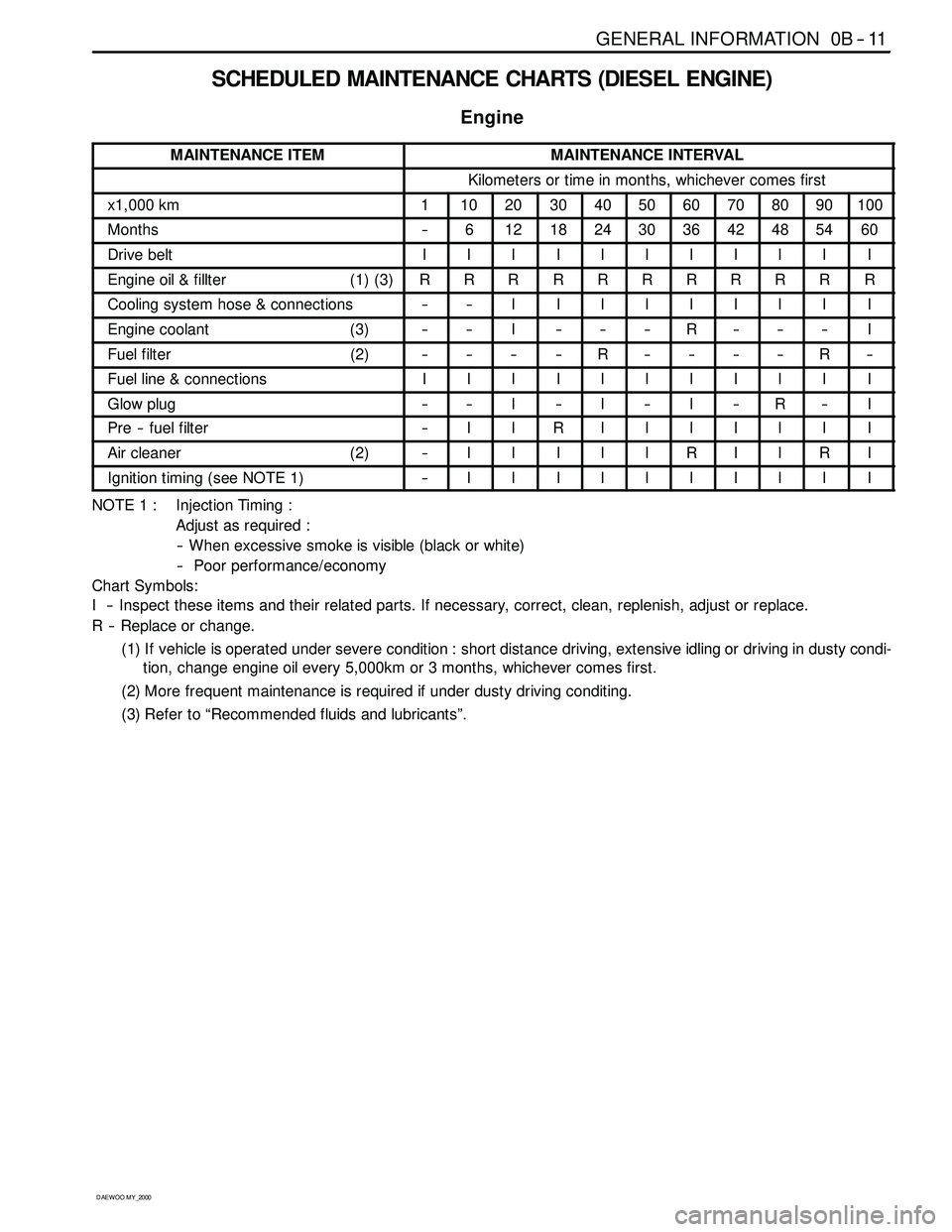
GENERAL INFORMATION 0B -- 11
D AEW OO M Y_2000
SCHEDULED MAINTENANCE CHARTS (DIESEL ENGINE)
Engine
MAINTENANCE ITEMMAINTENANCE INTERVAL
Kilometers or time in months, whichever comes first
x1,000 km1102030405060708090100
Months--6121824303642485460
Drive beltIIIIIIIIIII
Engine oil & fillter (1) (3)RRRRRRRRRRR
Cooling system hose & connections----IIIIIIIII
Engine coolant (3)----I------R------I
Fuel filter (2)--------R--------R--
Fuel line & connectionsIIIIIIIIIII
Glow plug----I--I--I--R--I
Pre -- fuel filter--IIRIIIIIII
Air cleaner (2)--IIIIIRIIRI
Ignition timing (see NOTE 1)--IIIIIIIIII
NOTE 1 : Injection Timing :
Adjust as required :
-- When excessive smoke is visible (black or white)
-- Poor performance/economy
Chart Symbols:
I -- Inspect these items and their related parts. If necessary, correct, clean, replenish, adjust or replace.
R -- Replace or change.
(1) If vehicle is operated under severe condition : short distance driving, extensive idling or driving in dusty condi-
tion, change engine oil every 5,000km or 3 months, whichever comes first.
(2) More frequent maintenance is required if under dusty driving conditing.
(3) Refer to “Recommended fluids and lubricants”.
Page 12 of 2053
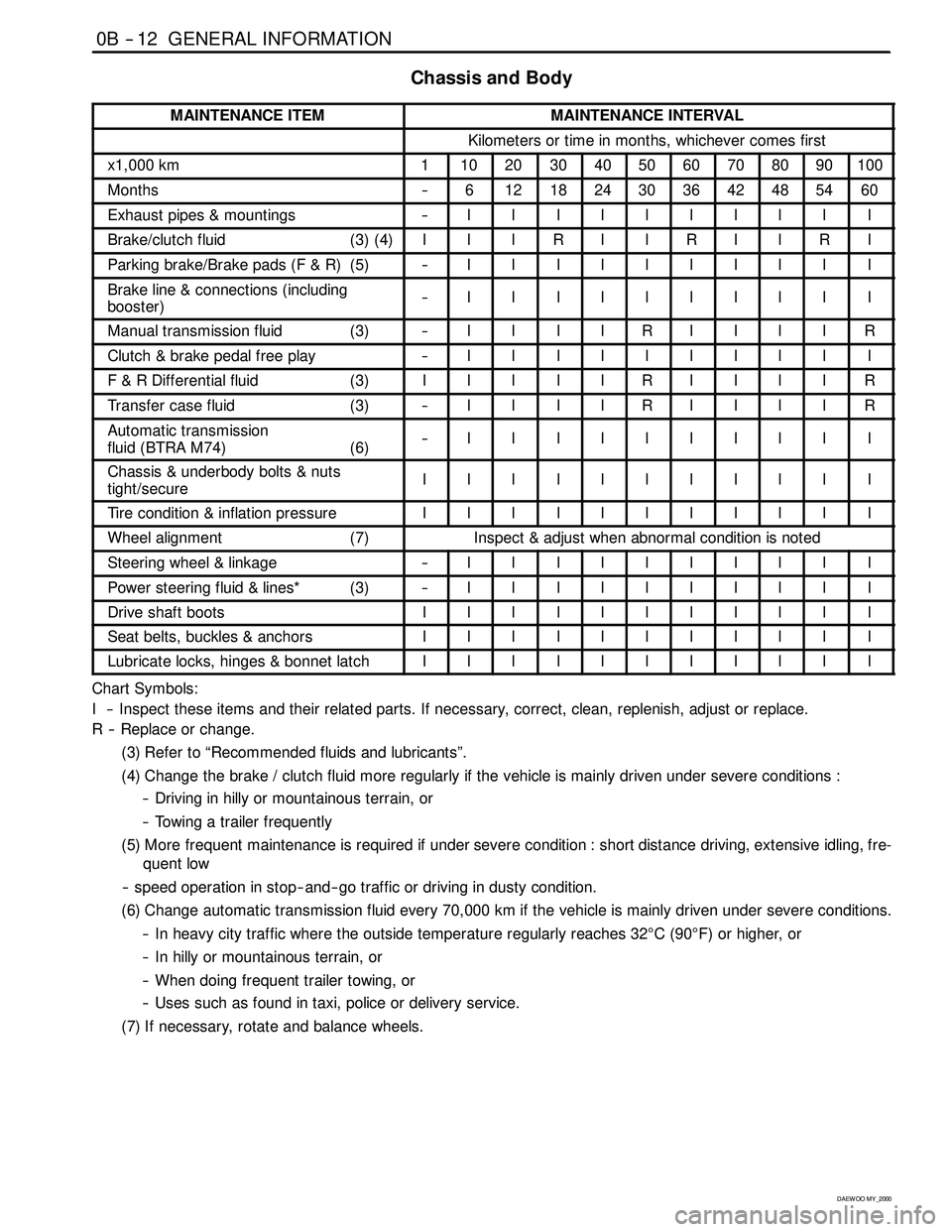
0B -- 12 GENERAL INFORMATION
D AEW OO M Y_2000
Chassis and Body
MAINTENANCE ITEMMAINTENANCE INTERVAL
Kilometers or time in months, whichever comes first
x1,000 km1102030405060708090100
Months--6121824303642485460
Exhaust pipes & mountings--IIIIIIIIII
Brake/clutch fluid (3) (4)IIIRIIRIIRI
Parking brake/Brake pads (F & R) (5)--IIIIIIIIII
Brake line & connections (including
booster)--IIIIIIIIII
Manual transmission fluid (3)--IIIIRIIIIR
Clutch & brake pedal free play--IIIIIIIIII
F & R Differential fluid (3)IIIIIRIIIIR
Transfer case fluid (3)--IIIIRIIIIR
Automatic transmission
fluid (BTRA M74) (6)--IIIIIIIIII
Chassis & underbody bolts & nuts
tight/secureIIIIIIIIIII
Tire condition & inflation pressureIIIIIIIIIII
Wheel alignment (7)Inspect & adjust when abnormal condition is noted
Steering wheel & linkage--IIIIIIIIII
Power steering fluid & lines* (3)--IIIIIIIIII
Drive shaft bootsIIIIIIIIIII
Seat belts, buckles & anchorsIIIIIIIIIII
Lubricate locks, hinges & bonnet latchIIIIIIIIIII
Chart Symbols:
I -- Inspect these items and their related parts. If necessary, correct, clean, replenish, adjust or replace.
R -- Replace or change.
(3) Refer to “Recommended fluids and lubricants”.
(4) Change the brake / clutch fluid more regularly if the vehicle is mainly driven under severe conditions :
-- Driving in hilly or mountainous terrain, or
-- Towing a trailer frequently
(5) More frequent maintenance is required if under severe condition : short distance driving, extensive idling, fre-
quent low
-- speed operation in stop-- and-- go traffic or driving in dusty condition.
(6) Change automatic transmission fluid every 70,000 km if the vehicle is mainly driven under severe conditions.
-- In heavy city traffic where the outside temperature regularly reaches 32°C(90°F) or higher, or
-- In hilly or mountainous terrain, or
-- When doing frequent trailer towing, or
-- Uses such as found in taxi, police or delivery service.
(7) If necessary, rotate and balance wheels.
Page 13 of 2053
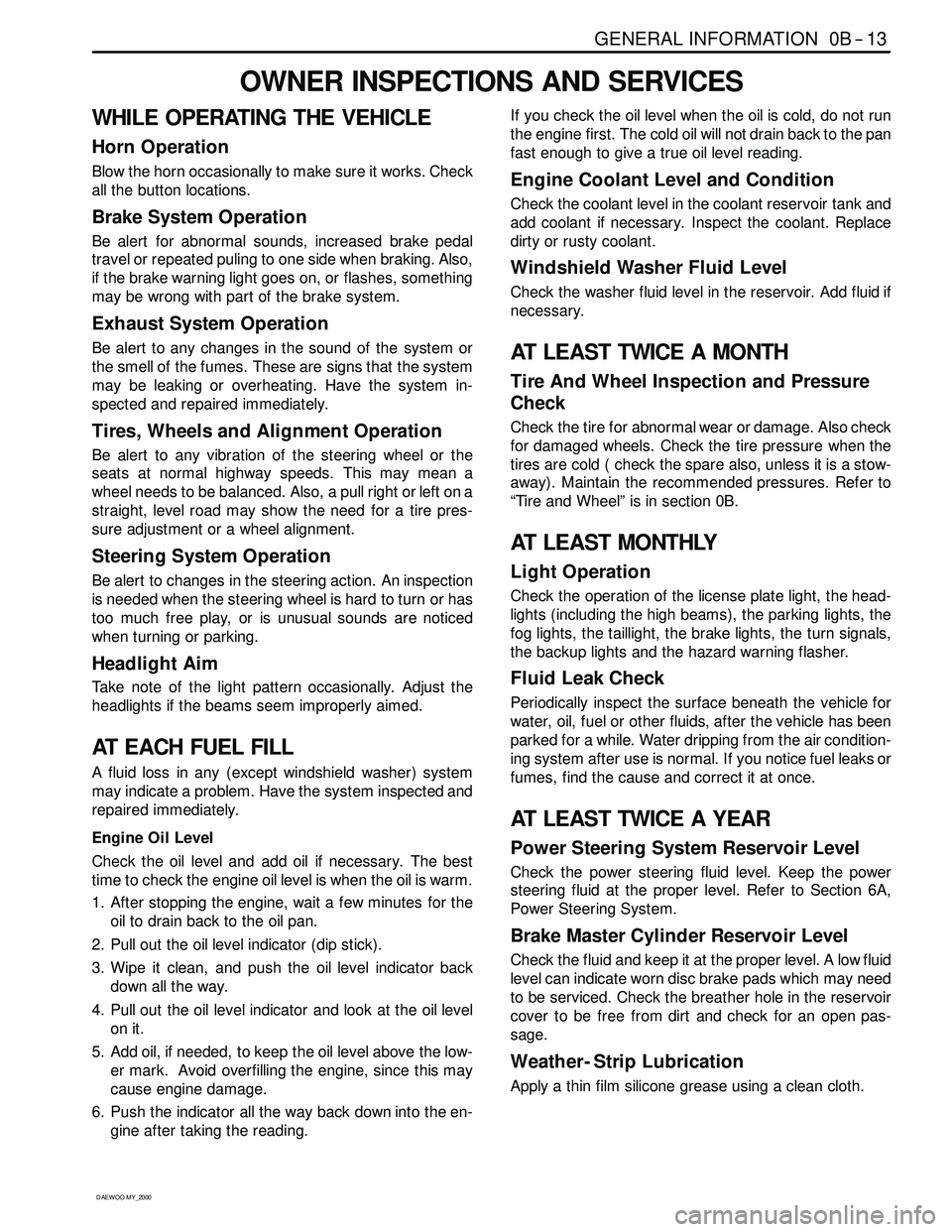
GENERAL INFORMATION 0B -- 13
D AEW OO M Y_2000
OWNER INSPECTIONS AND SERVICES
WHILE OPERATING THE VEHICLE
Horn Operation
Blow the horn occasionally to make sure it works. Check
all the button locations.
Brake System Operation
Be alert for abnormal sounds, increased brake pedal
travel or repeated puling to one side when braking. Also,
if the brake warning light goes on, or flashes, something
may be wrong with part of the brake system.
Exhaust System Operation
Be alert to any changes inthe sound of the system or
the smell of the fumes. These are signs that the system
may be leaking or overheating. Have the system in-
spected and repaired immediately.
Tires, Wheels and Alignment Operation
Be alert to any vibration of the steering wheel or the
seats at normal highway speeds. This may mean a
wheel needs to be balanced. Also, a pull right or left on a
straight, level road may show the need for a tire pres-
sure adjustment or a wheel alignment.
Steering System Operation
Be alert to changes in the steering action. An inspection
is needed when the steering wheel is hard to turn or has
too much free play, or is unusual sounds are noticed
when turning or parking.
Headlight Aim
Take note of the light pattern occasionally. Adjust the
headlights if the beams seem improperly aimed.
AT EACH FUEL FILL
A fluid loss in any (except windshield washer) system
may indicate a problem. Have the system inspected and
repaired immediately.
Engine Oil Level
Check the oil level and add oil if necessary. The best
time to check the engine oil level is when the oil is warm.
1. After stopping the engine, wait a few minutes for the
oil to drain back to the oil pan.
2. Pull out the oil level indicator (dip stick).
3. Wipe it clean, and push the oil level indicator back
down all the way.
4. Pull out the oil level indicator and look at the oil level
on it.
5. Add oil, if needed, to keep the oil level above the low-
er mark. Avoid overfilling theengine, since this may
cause engine damage.
6. Push the indicator all the way back down into the en-
gine after taking the reading.If you check the oil level when the oil is cold, do not run
the engine first. The cold oil will not drain back to the pan
fast enough to give a true oil level reading.
Engine Coolant Level and Condition
Check the coolant level in the coolant reservoir tank and
add coolant if necessary. Inspect the coolant. Replace
dirty or rusty coolant.
Windshield Washer Fluid Level
Check the washer fluid level in the reservoir. Add fluid if
necessary.
AT LEAST TWICE A MONTH
Tire And Wheel Inspection and Pressure
Check
Check the tire for abnormal wear or damage. Also check
for damaged wheels. Check the tire pressure when the
tires are cold ( check the spare also, unless it is a stow-
away). Maintain the recommended pressures. Refer to
“Tire and Wheel” is in section 0B.
AT LEAST MONTHLY
Light Operation
Check the operation of the license plate light, the head-
lights (including the high beams), the parking lights, the
fog lights, the taillight, the brake lights, the turn signals,
the backup lights and the hazard warning flasher.
Fluid Leak Check
Periodically inspect the surface beneath the vehicle for
water, oil, fuel or other fluids, after the vehicle has been
parked for a while. Water dripping from the air condition-
ing system after use is normal. If you notice fuel leaks or
fumes, find the cause and correct it at once.
AT LEAST TWICE A YEAR
Power Steering System Reservoir Level
Check the power steering fluid level. Keep the power
steering fluid at the proper level. Refer to Section 6A,
Power Steering System.
Brake Master Cylinder Reservoir Level
Check the fluid and keep it at the proper level. A low fluid
level can indicate worn disc brake pads which may need
to be serviced. Check the breather hole in the reservoir
cover to be free from dirt and check for an open pas-
sage.
Weather- Strip Lubrication
Apply a thin film silicone grease using a clean cloth.
Page 14 of 2053
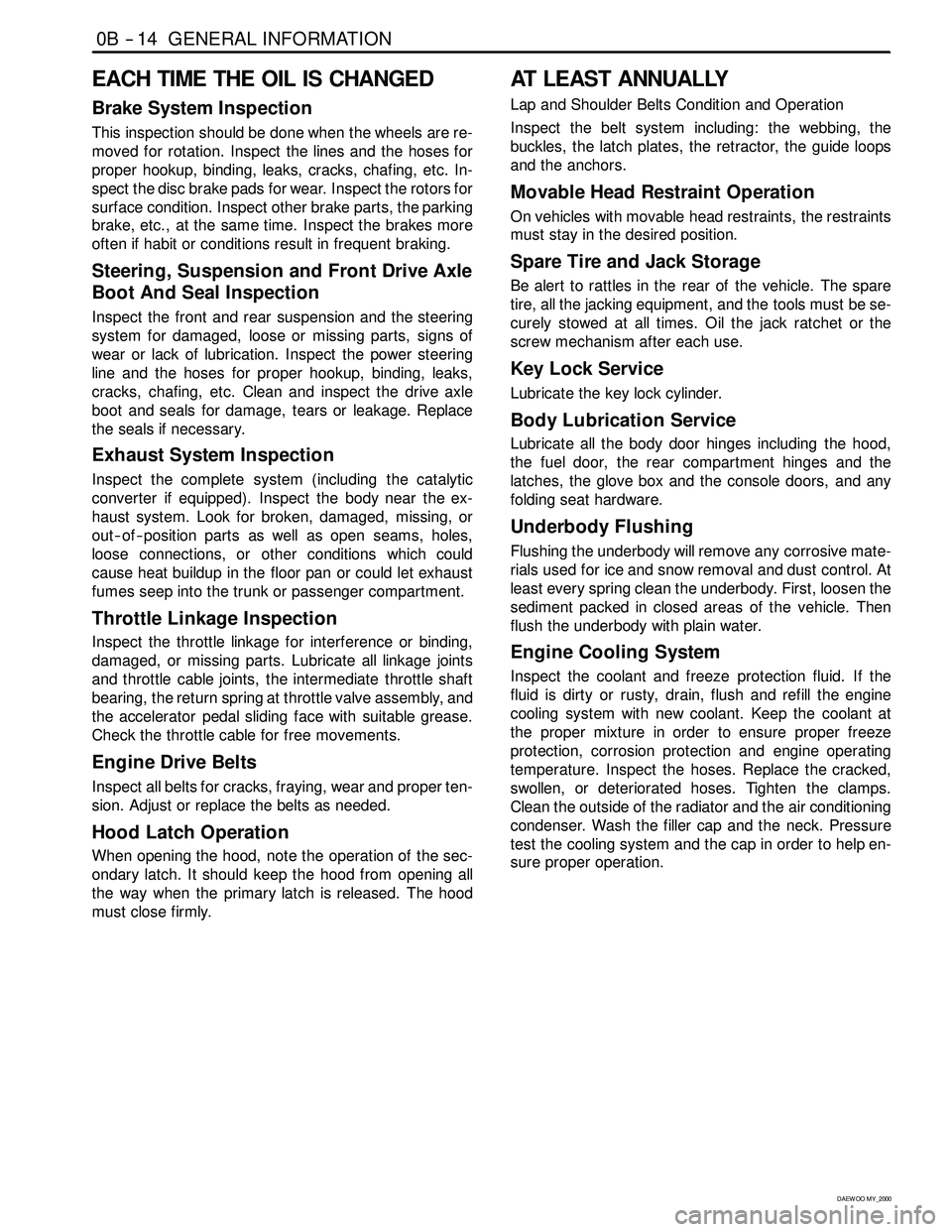
0B -- 14 GENERAL INFORMATION
D AEW OO M Y_2000
EACH TIME THE OIL IS CHANGED
Brake System Inspection
This inspection should be done when the wheels are re-
moved for rotation. Inspect the lines and the hoses for
proper hookup, binding, leaks, cracks, chafing, etc. In-
spect the disc brake pads for wear. Inspect the rotors for
surface condition. Inspect other brake parts, the parking
brake, etc., at the same time. Inspect the brakes more
often if habit or conditions result in frequent braking.
Steering, Suspension and Front Drive Axle
Boot And Seal Inspection
Inspect the front and rear suspension and the steering
system for damaged, loose or missing parts, signs of
wear or lack of lubrication. Inspect the power steering
line and the hoses for proper hookup, binding, leaks,
cracks, chafing, etc. Clean and inspect the drive axle
boot and seals for damage, tears or leakage. Replace
the seals if necessary.
Exhaust System Inspection
Inspect the complete system (including the catalytic
converter if equipped). Inspect the body near the ex-
haust system. Look for broken, damaged, missing, or
out -- of -- position parts as well as open seams, holes,
loose connections, or other conditions which could
cause heat buildup in the floor pan or could let exhaust
fumes seep into the trunk or passenger compartment.
Throttle Linkage Inspection
Inspect the throttle linkage for interference or binding,
damaged, or missing parts. Lubricate all linkage joints
and throttle cable joints, the intermediate throttle shaft
bearing, the return spring at throttle valve assembly, and
the accelerator pedal sliding face with suitable grease.
Check the throttle cable for free movements.
Engine Drive Belts
Inspect all belts for cracks, fraying, wear and proper ten-
sion. Adjust or replace the belts as needed.
Hood Latch Operation
When opening the hood, note the operation of the sec-
ondary latch. It should keep the hood from opening all
the way when the primary latch is released. The hood
must close firmly.
AT LEAST ANNUALLY
Lap and Shoulder Belts Condition and Operation
Inspect the belt system including: the webbing, the
buckles, the latch plates, the retractor, the guide loops
and the anchors.
Movable Head Restraint Operation
On vehicles with movable head restraints, the restraints
must stay in the desired position.
Spare Tire and Jack Storage
Be alert to rattles in the rear of the vehicle. The spare
tire, all the jacking equipment, and the tools must be se-
curely stowed at all times. Oil the jack ratchet or the
screw mechanism after each use.
Key Lock Service
Lubricate the key lock cylinder.
Body Lubrication Service
Lubricate all the body door hinges including the hood,
the fuel door, the rear compartment hinges and the
latches, the glove box and the console doors, and any
folding seat hardware.
Underbody Flushing
Flushing the underbody will remove any corrosive mate-
rials used for ice and snow removal and dust control. At
least every spring clean the underbody. First, loosen the
sediment packed in closed areas of the vehicle. Then
flush the underbody with plain water.
Engine Cooling System
Inspect the coolant and freeze protection fluid. If the
fluid is dirty or rusty, drain, flush and refill the engine
cooling system with new coolant. Keep the coolant at
the proper mixture in order to ensure proper freeze
protection, corrosion protection and engine operating
temperature. Inspect the hoses. Replace the cracked,
swollen, or deteriorated hoses. Tighten the clamps.
Clean the outside of the radiator and the air conditioning
condenser. Wash the filler cap and the neck. Pressure
test the cooling system and the cap in order to help en-
sure proper operation.
Page 15 of 2053
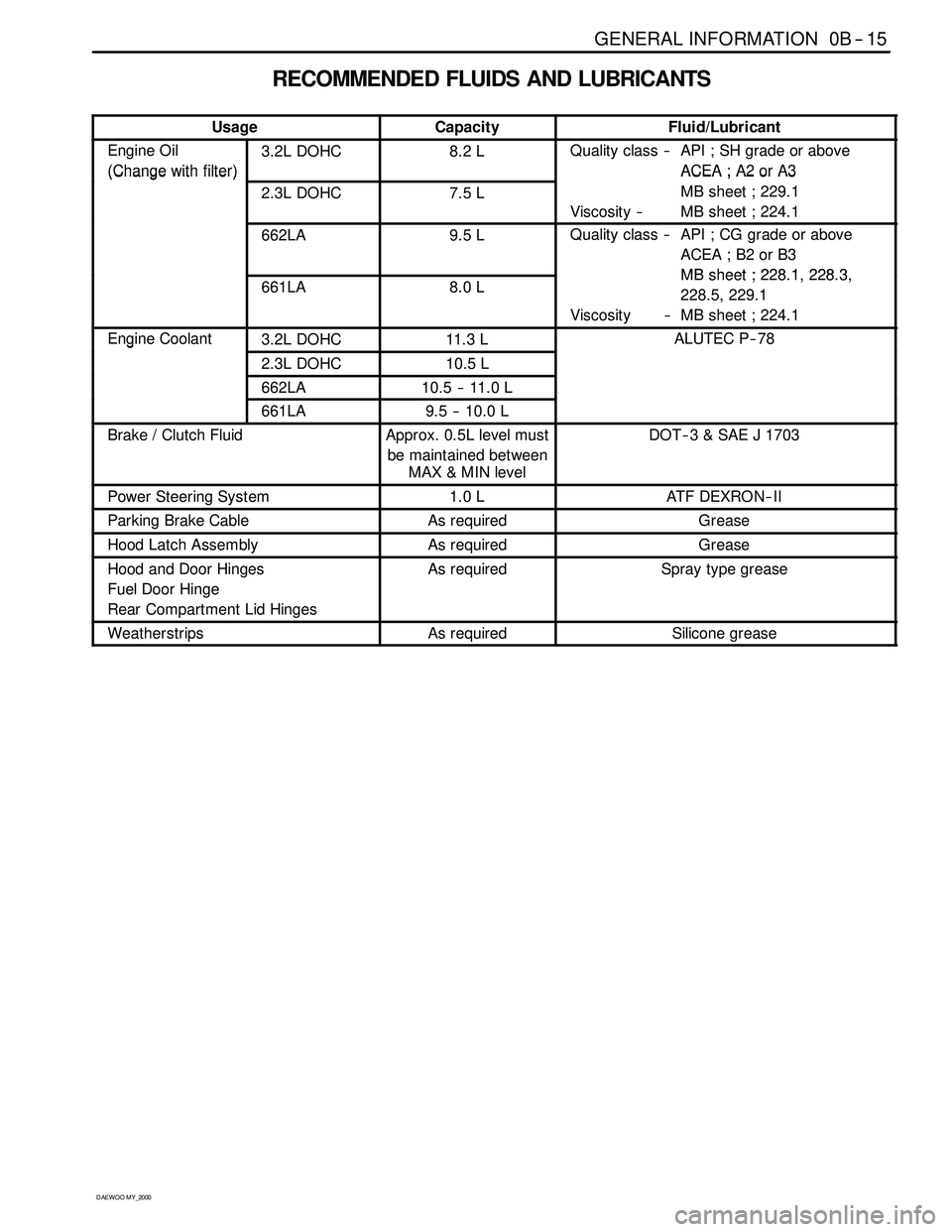
GENERAL INFORMATION 0B -- 15
D AEW OO M Y_2000
RECOMMENDED FLUIDS AND LUBRICANTS
UsageCapacityFluid/Lubricant
Engine Oil
(Change with filter)3.2L DOHC8.2 LQuality class -- API ; SH grade or above
ACEA ; A2 or A3
(Changewithfilter)
2.3L DOHC7.5 L
ACEA;A2orA3
MB sheet ; 229.1
Viscosity -- MB sheet ; 224.1
662LA9.5 LQuality class -- API ; CG grade or above
ACEA ; B2 or B3
MBsheet;22812283661LA8.0 LMBsheet ; 228.1, 228.3,
228.5, 229.1
Viscosity -- MB sheet ; 224.1
Engine Coolant3.2L DOHC11. 3 LALUTEC P-- 78g
2.3L DOHC10.5 L
662LA10.5 -- 11.0 L
661LA9.5 -- 10.0 L
Brake / Clutch FluidApprox. 0.5L level must
be maintained between
MAX&MINlevelDOT -- 3 & SAE J 1703
Power Steering System1.0 LATF DEXRON--II
Parking Brake CableAs requiredGrease
Hood Latch AssemblyAs requiredGrease
Hood and Door Hinges
Fuel Door Hinge
Rear Compartment Lid HingesAs requiredSpray type grease
WeatherstripsAs requiredSilicone grease
Page 16 of 2053
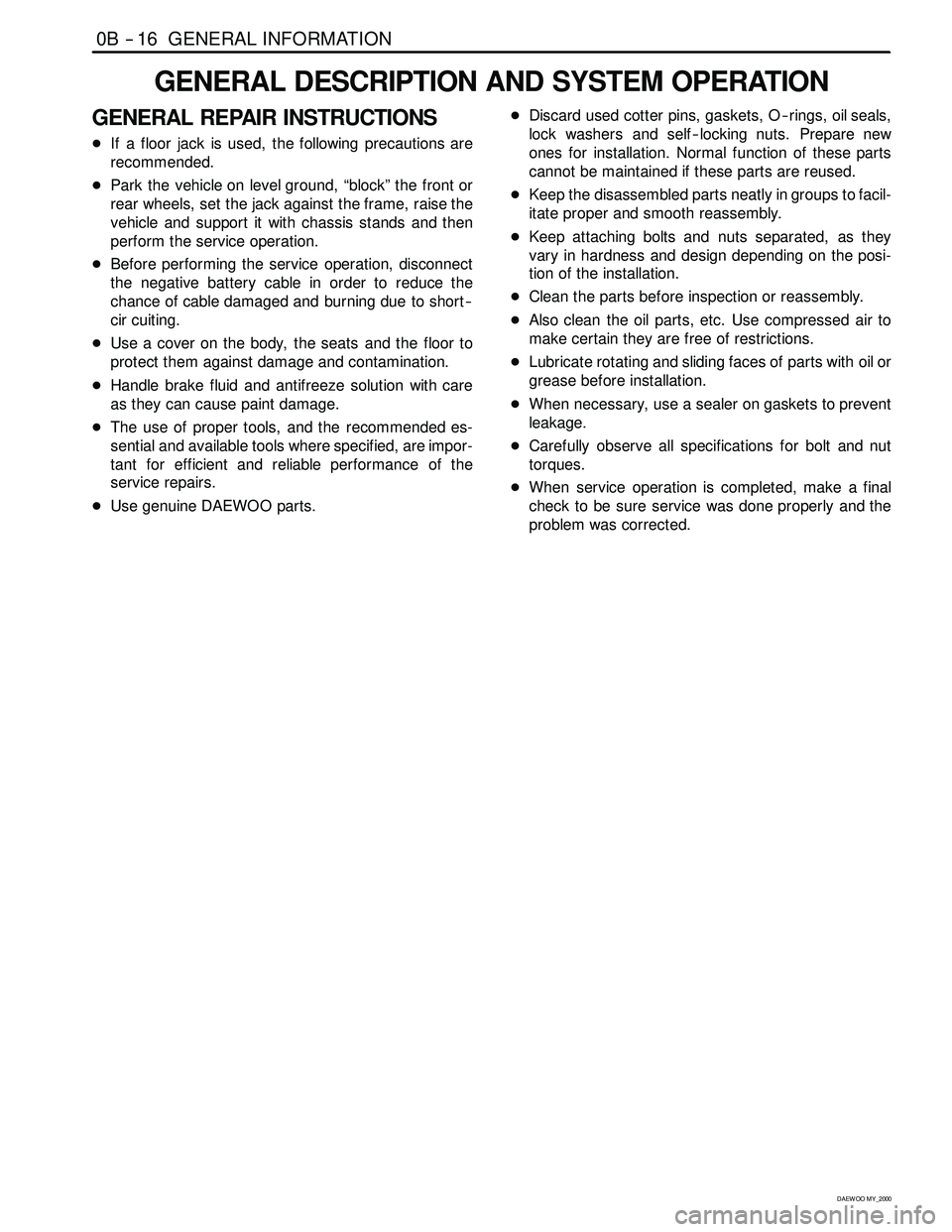
0B -- 16 GENERAL INFORMATION
D AEW OO M Y_2000
GENERAL DESCRIPTION AND SYSTEM OPERATION
GENERAL REPAIR INSTRUCTIONS
DIf a floor jack is used, the following precautions are
recommended.
DPark the vehicle on level ground, “block” the front or
rear wheels, set the jack against the frame, raise the
vehicle and support it with chassis stands and then
perform the service operation.
DBefore performing the service operation, disconnect
the negative battery cable in order to reduce the
chance of cable damaged and burning due to short --
cir cuiting.
DUse a cover on the body, the seats and the floor to
protect them against damage and contamination.
DHandle brake fluid and antifreeze solution with care
as they can cause paint damage.
DThe use of proper tools, and the recommended es-
sential and available tools where specified, are impor-
tant for efficient and reliable performance of the
service repairs.
DUse genuine DAEWOO parts.DDiscard used cotter pins, gaskets, O -- rings, oil seals,
lock washers and self -- locking nuts. Prepare new
ones for installation. Normal function of these parts
cannot be maintained if these parts are reused.
DKeep the disassembled parts neatly in groups to facil-
itate proper and smooth reassembly.
DKeep attaching bolts and nuts separated, as they
vary in hardness and design depending on the posi-
tion of the installation.
DClean the parts before inspection or reassembly.
DAlso clean the oil parts, etc. Use compressed air to
make certain they are free of restrictions.
DLubricate rotating and sliding faces of parts with oil or
grease before installation.
DWhen necessary, use a sealer on gaskets to prevent
leakage.
DCarefully observe all specifications for bolt and nut
torques.
DWhen service operation is completed, make a final
check to be sure service was done properly and the
problem was corrected.
Page 17 of 2053

GENERAL INFORMATION 0B -- 17
D AEW OO M Y_2000
VEHICLE IDENTIFICATION NUMBER SYSTEM
Page 18 of 2053
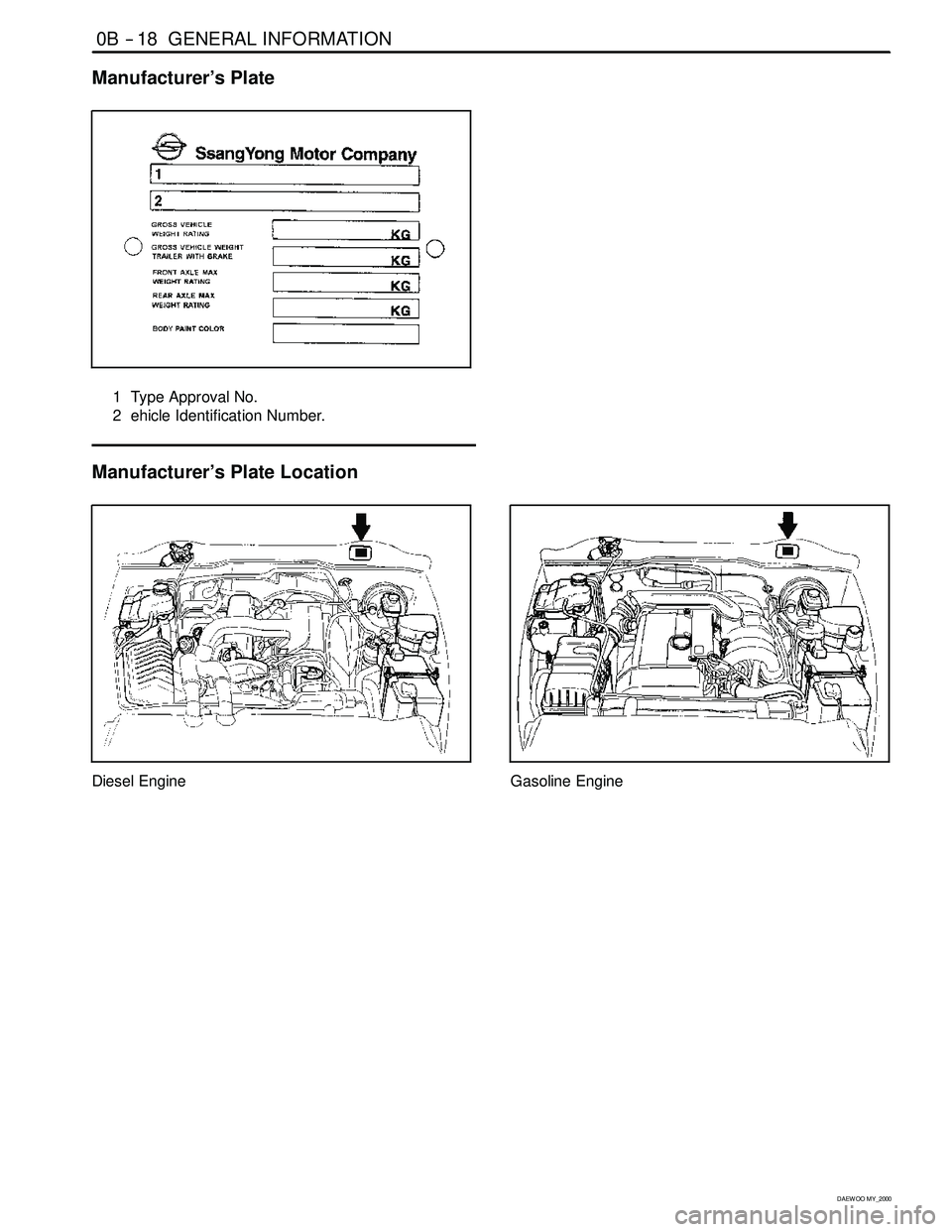
0B -- 18 GENERAL INFORMATION
D AEW OO M Y_2000
Manufacturer’s Plate
1 Type Approval No.
2 ehicle Identification Number.
Manufacturer’s Plate Location
Diesel EngineGasoline Engine
Page 19 of 2053

GENERAL INFORMATION 0B -- 19
D AEW OO M Y_2000
Gasolind Engine NumberDiesel Engine Number
Engine Number Location
Diesel Engine
The engine number is stamped on the cylinder block in
front of injection pump.
IL6 3200 Gasolind Engine
The engine number is stamped on the lower rear side of
the alternator.
Page 20 of 2053

0B -- 20 GENERAL INFORMATION
D AEW OO M Y_2000
2300 DOHC Gasolind Engine
The engine number is stamped on the upper rear left --
hand side of the cylinder block.
VEHICLE LIFTING PROCEDURES
To raise the vehicle, place the lifting equipment only at
the points indicated. Failure to use these precise posi-
tions may result in permanent vehicle body deformation.
Many dealer service facilities and service stations are
equipped with automative hoists that bear upon some
parts of the frame in order to lift the vehicle. If any other
hoist method is used, take special care to avoid damag-
ing the fuel tank, the filter neck, the exhaust system, or
the underbody.
Vehicle Lifting Points
Using Jack
(Rearward of Front Tire)
Using Jack
(Forward of Rear Tire)